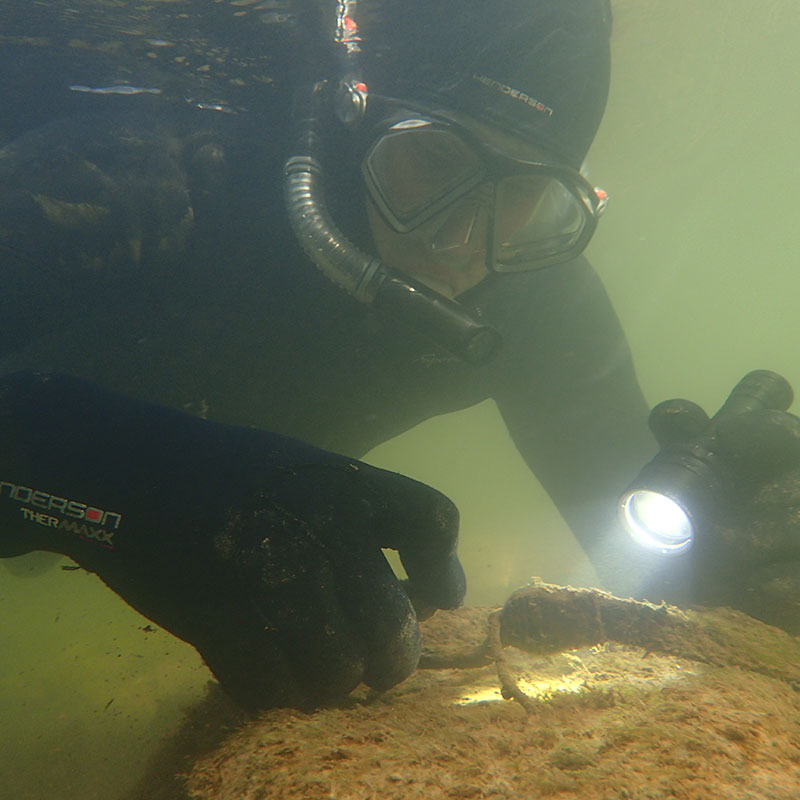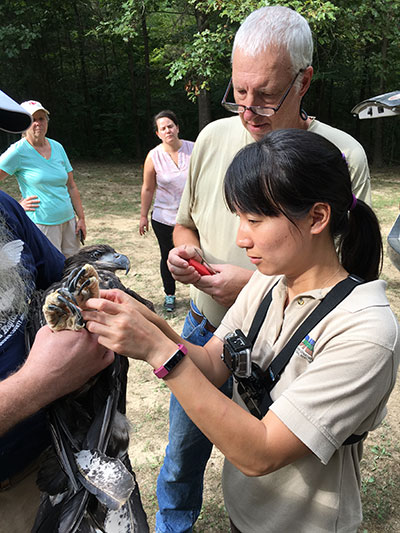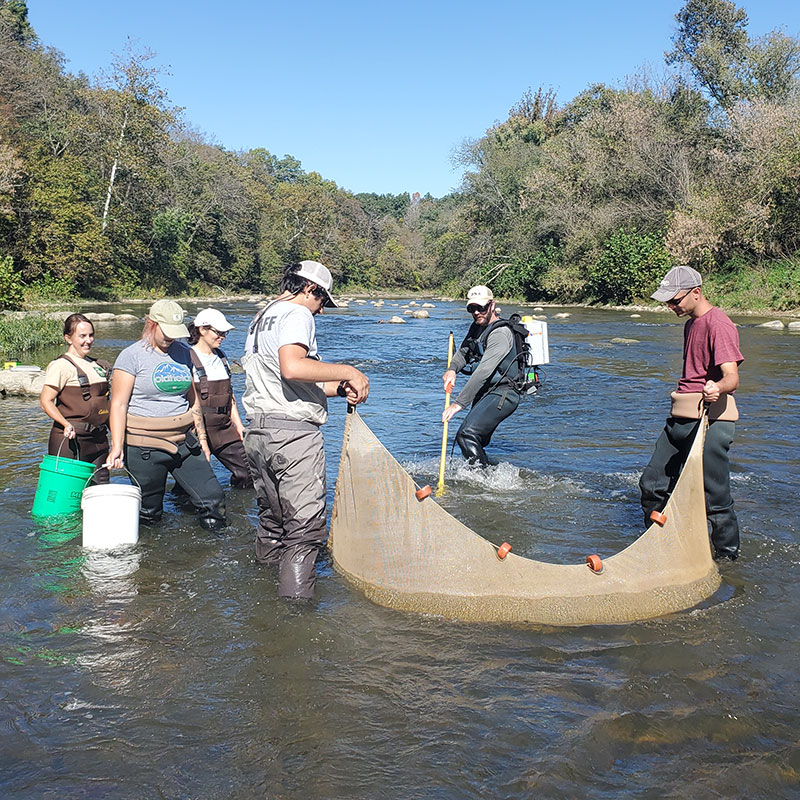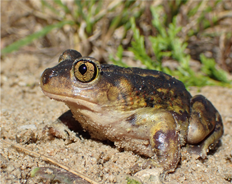Select image to enlarge and view caption.
When species thrive, so do we
Wildlife and the natural systems that support it need variety to be healthy. Each unique animal contributes to this balance. Our best success stories include recovery of fish and wildlife species to a point at which they can live and thrive on their own again in the state. Click on a story below to see just a few examples.
The best part? We thrive alongside our wildlife. When our most sensitive species flourish, it is a sign of a cleaner and healthier environment for us, too.
- Helping hellbenders in the Blue River
Indiana’s hellbender populations have declined for decades. The last remaining population lives in the Blue River. The large, brown aquatic salamander breathes through wrinkly folds on its skin and is currently being aided by researchers to support its recovery. Each year since 2017, the DNR has worked with Purdue University and partnering zoos to release juvenile captive-raised hellbenders into the Blue River to augment its declining population. In 2023, biologists with the Indiana DNR and Purdue University documented a very young hellbender salamander, a gilled larva, in the Blue River while conducting routine surveys in south-central Indiana. This discovery is significant because over the past three to four decades, only adult hellbenders have been documented in the Blue River. The presence of a young salamander suggests that conservation efforts and rearing programs are accomplishing their goals for the recovery of this endangered species. According to Nate Engbrecht, DNR herpetologist, Purdue and the DNR’s efforts have helped Indiana become a hub for hellbender studies. “I’m proud that Indiana has become a leader in hellbender research and conservation in the Midwest,” Engbrecht says.

DNR staff and partners track the survival of hellbenders in the Blue River.

- Expanding Indiana’s Bald Eagle Population
If you were born before the early 1990s, it’s likely you don’t remember seeing bald eagles as a kid. Although the bald eagle was once listed as endangered in Indiana, researchers have successfully increased the population through a reintroduction of chicks. Researchers like Al Parker and Allisyn Gillet have worked for years to capture the eagles and perform health checks on them. As the eagles grew, they kept tabs on the species, watching them fly to places like Alberta and New York. “It was kind of cool to see some of these birds really range far,” Parker said, with the hopes they’d return to Indiana to nest. Over the 1990s into the 2000s, bald eagle populations expanded. In 2020, Indiana delisted bald eagles from our Species of Special Concern, as the state reported 396 nests.

A state ornithologist places an identification band on a young bald eagle.

- Increasing freshwater mussel populations in rivers
Northern riffleshell and clubshell thrive in areas with clean, clear, swift-flowing water. Both of these federally endangered mussel species were once distributed within the Ohio River and Lake Erie drainages of Indiana but are now known to live in only in a few locations in the state. Augmenting populations of Northern riffleshell in the Tippecanoe River and reintroducing clubshell in the Eel River would provide a better opportunity for the continued persistence of both species in Indiana and help improve water quality.
To complete this translocation project, the Division of Fish & Wildlife collaborated with several partners. Adult Northern riffleshell and clubshell have been monitored for survival, growth, and movements since they were received from the Allegheny River in Pennsylvania. While survival of Northern riffleshell has been less than that of clubshell, it resembles what other states that received mussels have seen. Future efforts will include searches for juveniles of each species to determine if any successful reproduction is occurring.

DNR staff place ID tags on mussels to track their survival over time.

- Discovering previously unseen Tippecanoe darters
One of the smallest fish species in Indiana waters, the Tippecanoe darter rarely reaches 2 inches in length. Males at the peak of the spawning season are a vibrant orange, with bluish-blackish vertical bars along their sides. Females maintain a tannish-brownish coloration year-round.
This diminutive species lives in Indiana’s rivers and streams in rocky areas with good current, where it buries deep into the gravel and cobble. The Tippecanoe darter was once considered extremely rare in Indiana, known from only a few sporadic locations around the state. To gain a more complete understanding of its distribution, biologists developed specialized sampling techniques. They secure a small net in the stream in areas of good Tippecanoe darter habitat, and then they disturb the river bottom directly upstream with their feet. These targeted surveys revealed that the Tippecanoe darter was actually much more widely distributed than previously thought. As a result, in 2017, the Tippecanoe darter was delisted from Indiana’s list of Species of Greatest Conservation Need.

Focused survey efforts help DNR find undiscovered populations of the Tippecanoe Darter.

We have more success stories to share!
Visit the 40 stories project to read more about our species success stories and the DNR staff and donors who have made them possible.
Help us create many more success stories
Re-establishing a viable population of an at-risk species is neither a certainty nor an easy feat. Restoring wildlife takes time. It takes expertise. It takes commitment, and it takes caring people like you who support our work.
The Indiana Nongame Wildlife Fund provides a portion of funds behind these success stories and many more. Learn how you can contribute to this important work.
Species Recovery
While there remains much conservation to be done and many species to recover, there are some recent successes.
 Osprey
Osprey
In 2018 the osprey was down listed from State Endangered to Special Concern. Even though the Osprey, as a Special Concern species, remains a Species of Greatest Conservation Need, this down listing reflects the continued growth and expansion of Osprey in Indiana. This is a great success story and one that speaks to the value of diverse partnerships, the Indiana Nongame Wildlife Fund and the State Wildlife Grant program.
Northern Leopard Frog

During the latter half of the 20th century Northern leopard frogs experienced considerable declines in several parts of their range, including Indiana, and in 1984 were listed as a Species of Special Concern. However, the frogs have responded well to habitat restoration and are now relatively common in the northern part of the state. As such, in 2017 the Indiana Department of Natural Resources Amphibian and Reptile Technical Advisory Committee voted unanimously to delist Northern leopard frogs. In 2019 will be formally removed as a Species of Greatest Conservation Need.

Eastern Spadefoot Toad
Due to survey efforts demonstrating that this species was more common than originally thought, the Eastern Spadefoot Toad was removed as a Species of Greatest Conservation Need in 2018.
Tippecanoe Darter

Due to this fish’s ability to burrow deeply into the gravel beds of streams, it was historically under sampled. With improved sampling techniques this fish is found to be more common than originally thought. It was removed as a Species of Greatest Conservation Need in 2018.
Black Bear

Photo by
US Fish & Wildlife Service
Black Bears are expanding their range in neighboring states. The fact that there have been three confirmed bears in Indiana since 2015 speaks to this expansion into Indiana. As result Black Bear was added to Indiana’s Species of Greatest Conservation Need. Previously, the Black Bear was listed as extirpated. Even though it was added to the list, it is widely considered a good add because of its return to Indiana after over a century of being extirpated.
List of 2017 External (Partnership-based) Research Projects
- Assessing Hellbender Habitat for Potential Reintroductions
- Assessing Juvenile Survival in Eastern Hellbenders
- Efficacy of Using Environmental DNA (eDNA) to Detect Kirtland’s Snake
- Examining Urban and Rural White-tailed Deer: Mortality, Dispersal and Relatedness
- Genetic assessment of Crawfish Frog Populations in Indiana
- Movement and Harvest of Local Mallards from Urban Environments of Indiana
- Snake Fungal Disease Testing in Indiana
- Status of Blanding’s Turtle and Spotted Turtle Populations in Indiana
- Summer Bat Communities on DFW Properties
- Summer Ecology of the Northern Long-eared Bat
- Surveys for the Eastern Massasauga in Indiana
Land Acquisition
With the help of many conservation partners (9 NGO, 7 governmental agencies, 1 private industry and over 50 private citizens), the Indiana Department of Natural Resources has purchased 10,977 acres of habitat within SWAP identified Conservation Opportunity Areas (COA) since January 1, 2015.
| DNR Division | Number of of Acres |
|---|---|
| Fish and Wildlife | 1,989 |
| Forestry | 706 |
| Nature Preserves | 1,254 |
| State Parks & Reservoirs | 3 |
| Totals | 3,952 |
| DNR Division | Number of of Acres |
|---|---|
| Fish and Wildlife | 1,319 |
| Forestry | 424 |
| Nature Preserves | 2,080 |
| Outdoor Recreation | 11 |
| State Parks & Reservoirs | 1 |
| Totals | 3,835 |
| DNR Division | Number of of Acres |
|---|---|
| Fish and Wildlife | 461 |
| Forestry | 1 |
| Nature Preserves | 473 |
| Outdoor Recreation | 229 |
| Totals | 1,164 |
| DNR Division | Number of of Acres |
|---|---|
| Fish and Wildlife | 1,192 |
| Forestry | 109 |
| Nature Preserves | 699 |
| Outdoor Recreation | 9 |
| State Parks & Reservoirs | 17 |
| Totals | 2,026 |
Program Development
State Acres for Wildlife Enhancement Program (SAFE)
Indiana Division of Fish and Wildlife’s Private Lands Program utilized the State Wildlife Action Plan in the development of SAFE. SAFE enrollment started in 2008 and as of July 2018, Indiana has 58,567 acres enrolled. The purpose of the SAFE program is to:
- Restore grasslands and maintain them to ensure healthy, diverse grassland habitat types for the grassland focal species (Northern Bobwhite, Sedge Wren, Henslow’s Sparrow, Grasshopper Sparrow and Ring-necked Pheasant).
- Restore and enhance connectivity of hardwood forests for Indiana Bat.
- To restore wetland habitat on working lands for shorebirds.
For more information on SAFE program contact your Private Lands Biologist
Grasslands for Gamebirds and Songbirds Initiative (GGS)
The State Wildlife Action Plan was utilized in the development of this program by targeting areas of Indiana with the greatest potential for grassland habitat restoration and enhancement. Focal species are Northern Bobwhite, Henslow’s Sparrow, Loggerhead Shrike and Ring-necked Pheasant. In addition, this initiative will greatly benefit pollinator insects. GGS is an award winning partnership between Indiana Division of Fish and Wildlife, US Department of Agriculture, Natural Resources Foundation, private industry, other non-profit organizations and others.
Conservation On Rivers and Roadways Intended to Develop Opportunities for Resources and Species program (CORRIDORS)
This program gives priority to all State Wildlife Action Plan Conservation Opportunity Areas, rights-of-way along state and federal highways and 100-year flood plains of rivers to establish habitats for grassland dependent wildlife and pollinators.
Lake and River Enhancement Program (LARE)
LARE is grant program designed to provide technical and financial assistance for projects that protect and enhance aquatic fish and wildlife habitat on Indiana’s publicly accessible lakes, streams and rivers. Projects within State Wildlife Action Plan Conservation Opportunity Areas are given higher consideration when evaluating LARE applications.
Indiana Stream and Wetland Mitigation Program
Threats to species and habitats as identified in Indiana’s State Wildlife Action Plan were referenced in the development of this program. Indiana Stream and Wetland Mitigation Program is an in-lieu fee that allows IDNR to sell stream and wetland and mitigation credits for unavoidable impacts to waters of the United States. By referencing Indiana’s State Wildlife Action Plan, IDNR is able to focus credits within Conservation Opportunity Areas.
